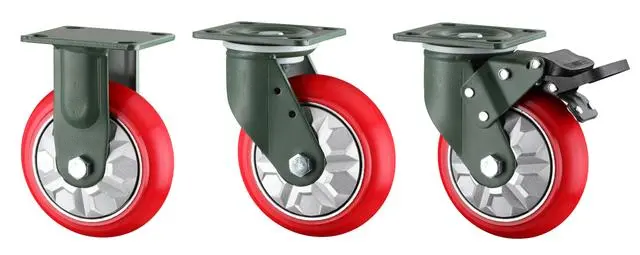Different Types of Polyurethane Coating Wheels
As a high-performance material with excellent physical properties and chemical stability, polyurethane occupies a core position in the field of wheel manufacturing. Its derived product types, with differentiated characteristics, meet diverse application needs. This article will systematically analyze the structural design, core advantages, and applicable scenarios of four mainstream polyurethane wheels to provide professional references for selection.

I. Thermoplastic Polyurethane (TPU) Wheels
TPU wheels adopt a composite structure of polypropylene or nylon wheel core + secondary injection-molded polyurethane tread, making them a classic model that balances practicality and adaptability. Their core advantages focus on floor protection and user experience: they leave no scratches or stains when rolling, effectively protecting precision floors such as epoxy floors, ceramic tiles, and wood floors; at the same time, they possess excellent shock absorption and buffering performance, combined with outstanding wear resistance and corrosion resistance, enabling smooth rolling on various working conditions such as concrete floors and plastic tracks. In addition, TPU materials support color customization on demand, meeting the appearance requirements of medical equipment, display racks, light-duty logistics vehicles, and other scenarios. It should be noted that high-temperature environments will reduce their load-bearing capacity, so it is recommended to use them within the conventional temperature range of -20℃~60℃.
II. Cast Polyurethane (CPU) Elastomer Wheels (High-Performance Version)
Made of thermosetting polyurethane elastomer homologous to basic CPU wheels, this high-performance product focuses more on adapting to dynamic working conditions in structural design and performance tuning. Its core highlights include an extremely low permanent deformation rate, maintaining its original shape even after long-term pressure bearing; at the same time, it has low rolling resistance and can stably withstand dynamic loads during high-speed operation, avoiding wheel damage caused by inertial impact. Specifically designed for high-demand scenarios, this type of wheel is widely used in AGVs (Automated Guided Vehicles), high-speed conveyor rollers, heavy-duty logistics turnover vehicles, and other equipment that requires long-term high-speed operation or frequent start-stop, balancing operational efficiency and stability.
Polyurethane Foam (PUE) Wheels
With a unique microporous structure, PUE wheels stand out as a differentiated product. Their low-density feature makes them much lighter than traditional polyurethane wheels, and when combined with deformable and high-elastic material properties, they achieve a perfect balance of "lightweight + high load-bearing capacity". In addition, their microporous structure endows them with excellent sound absorption, energy absorption, and shock absorption performance, resulting in low noise during pushing, effective buffering of road bumps, and excellent folding and tear resistance, preventing damage from collisions or extrusion. As an ideal choice for caster materials, PUE wheels are suitable for medical devices (such as wheelchairs and hospital beds), precision instrument handling vehicles, indoor silent carts, and other scenarios with strict requirements on weight, noise, and shock absorption.
Summary
Although the four types of polyurethane wheels are based on the same core material, they have formed distinct performance advantages through differentiated designs in wheel core materials and molding processes: TPU wheels excel in versatility and floor protection, basic CPU wheels are superior in comfort, durability, and outdoor adaptability, high-performance CPU wheels specialize in high-speed and heavy-load applications, while PUE wheels focus on lightweight and silent shock absorption as their core strengths.
In practical selection, comprehensive judgment should be made based on the operating environment (temperature, floor type), working condition requirements (load, operating speed), and core needs (appearance, noise, comfort). Choosing a suitable polyurethane wheel can not only improve equipment operational efficiency and extend service life but also provide double guarantees for operational safety and user experience, helping to achieve efficient operations in various fields.